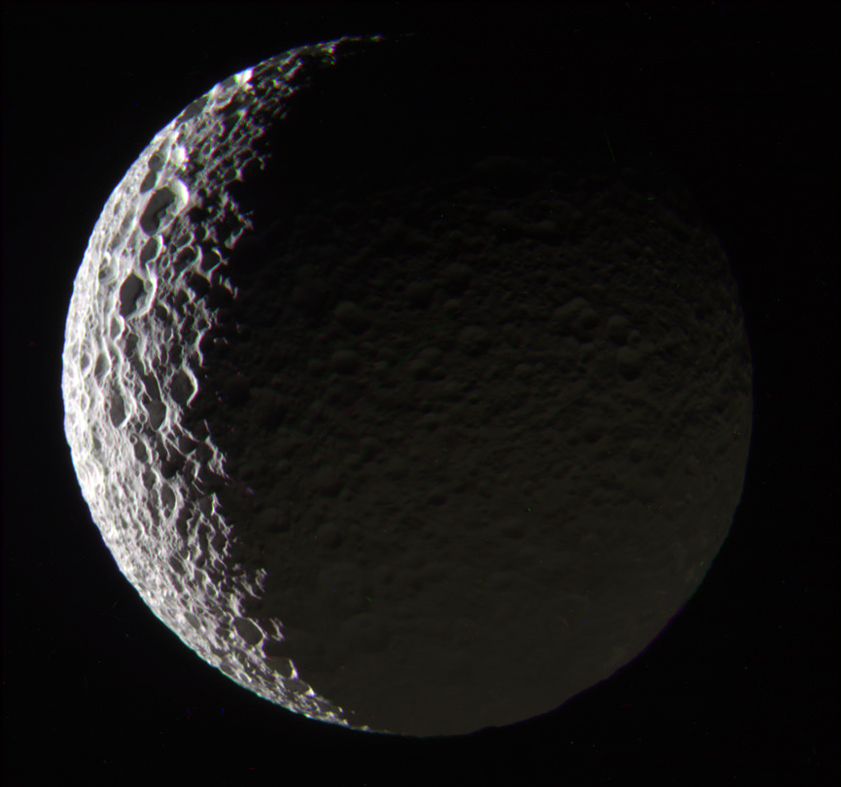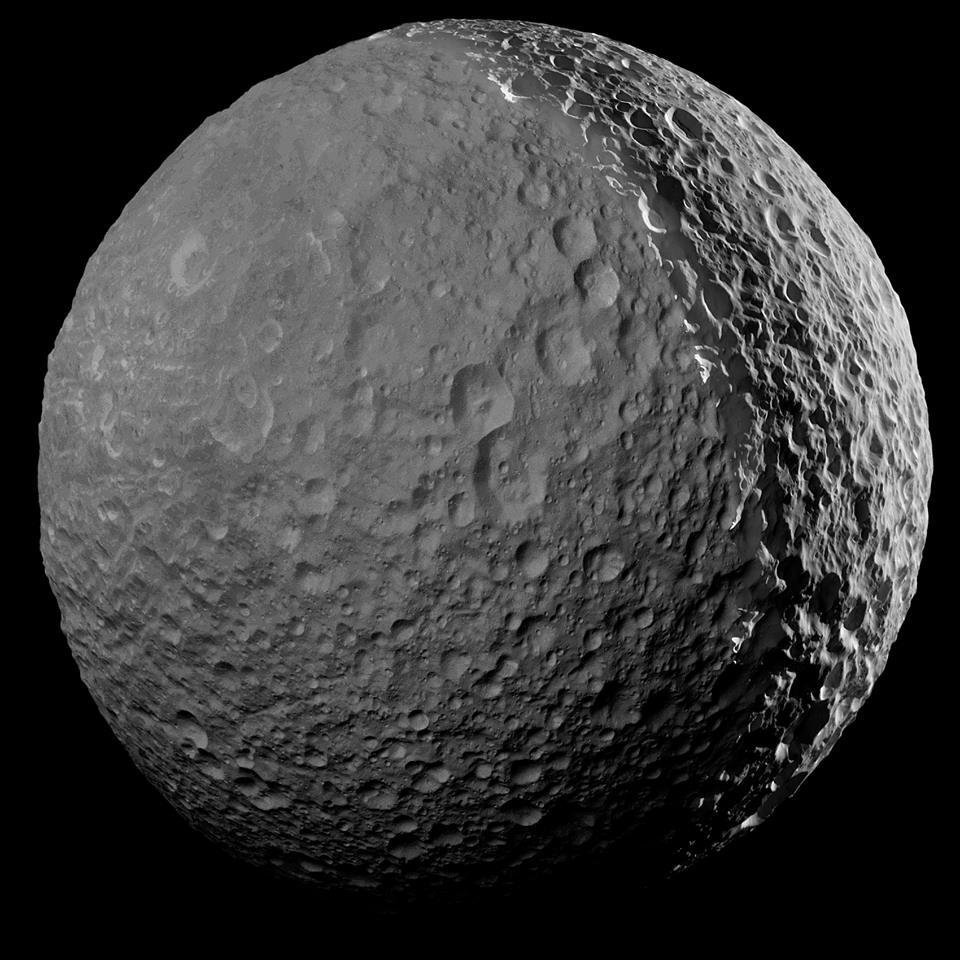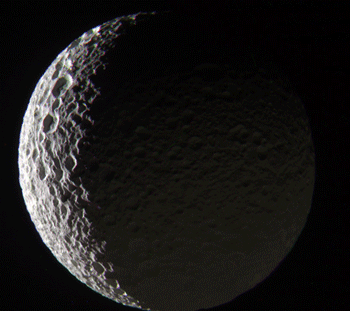It looks like you're using an Ad Blocker.
Please white-list or disable AboveTopSecret.com in your ad-blocking tool.
Thank you.
Some features of ATS will be disabled while you continue to use an ad-blocker.
share:
That is certainly a well-battered little sponge cake. Even if I had no idea of it's orbit, I would guess it to be near the main body of the debris
cloud/ring system.
Thank you. That's a great image.
Thank you. That's a great image.
a reply to: carewemust
shhh...don't speak too loud, nothing to see here.
saturndeathcult.com...
I rewatched Interstellar again the other night. Funny how they said in the movie that a wormhole appeared near Saturn to enable wormhole travel to save the Earth
If true, shouldn't the "clump" that coalesced into the Saturn and it's moons, be made of the same material..thereby causing all the moons to look nearly the same?
shhh...don't speak too loud, nothing to see here.
saturndeathcult.com...
I rewatched Interstellar again the other night. Funny how they said in the movie that a wormhole appeared near Saturn to enable wormhole travel to save the Earth
originally posted by: TheConstruKctionofLight
a reply to: hutch622
First thing i thought of was golf ball before they became cut proof
Same here - those craters look mighty deep if its diameter is 396 kms
That would be because Mimas is mostly ice rather than rock. Impacts in ice are deeper and sharper than in rock.
a reply to: carewemust
carewemust,
By the logic you are using to query the construction of Saturn's moons, their variety and disposition, one would assume that all the worlds orbiting our Sun ought to be made of largely the same things, and look relatively similar. This is, of course, flawed thinking.
Saturn and Jupiter have large gravity wells, larger than any body in the solar system other than the Sun itself. This means that their moons behaviour relative to them, is more similar to that of planets around a star, than it is to that of a mere moon around a planet.
Those moons formed out of what was left over from the formation of the planet itself, and in similar ways to the way that planets formed around the sun. The gravity well of the planet captured the chemicals of which those moons are made, and because those chemicals have different mass and weight and so on, they coalesced at different distances from the parent planet. Jupiter and Saturn are like microcosms of a solar system, having as they do complex systems of orbiting moons in their own right. When spacecraft pass through or close by Jupiter's gravity well, those craft are considered not to simply be visiting Jupiter, but to be visiting the Jovian system, for precisely this reason. You could say the same of Saturn without being in error.
carewemust,
By the logic you are using to query the construction of Saturn's moons, their variety and disposition, one would assume that all the worlds orbiting our Sun ought to be made of largely the same things, and look relatively similar. This is, of course, flawed thinking.
Saturn and Jupiter have large gravity wells, larger than any body in the solar system other than the Sun itself. This means that their moons behaviour relative to them, is more similar to that of planets around a star, than it is to that of a mere moon around a planet.
Those moons formed out of what was left over from the formation of the planet itself, and in similar ways to the way that planets formed around the sun. The gravity well of the planet captured the chemicals of which those moons are made, and because those chemicals have different mass and weight and so on, they coalesced at different distances from the parent planet. Jupiter and Saturn are like microcosms of a solar system, having as they do complex systems of orbiting moons in their own right. When spacecraft pass through or close by Jupiter's gravity well, those craft are considered not to simply be visiting Jupiter, but to be visiting the Jovian system, for precisely this reason. You could say the same of Saturn without being in error.
Another version of the true-colour image I posted earlier:

You can tell that it's ice surface, not rock.

You can tell that it's ice surface, not rock.
a reply to: wildespace
Indeed.
That glare from the crater edges in the top left quadrant of the image is clearly a reflection from ice, as opposed to some sort of metallic substance.
Indeed.
That glare from the crater edges in the top left quadrant of the image is clearly a reflection from ice, as opposed to some sort of metallic substance.
Turns out, those are Cassini's last closeup images of Mimas! All future observations of Mimas will be from more than twice this distance... So it's
time to say Goodbye, Mimas, and thanks for all the Star Wars
jokes.
Here's one of those latest shots, enhanced to better show the night side, lit by santurnshine: photojournal.jpl.nasa.gov...

Here's one of those latest shots, enhanced to better show the night side, lit by santurnshine: photojournal.jpl.nasa.gov...

I did a little image enhancement to see what details I could bring out:


new topics
-
Watts home paranormal activity
Paranormal Studies: 6 hours ago -
So, what is really going on in South Korea ?
World War Three: 7 hours ago -
Congress Says the FBI is Covering Up Vital Info on the Jan 5th 2021 D.C. Pipe Bombs at RNC-DNC.
Political Conspiracies: 7 hours ago -
The trial on kids was stopped
Medical Issues & Conspiracies: 10 hours ago
top topics
-
Biden to award Presidential Citizens Medal to Liz Cheney and Bennie Thompson
US Political Madness: 15 hours ago, 11 flags -
Biden Has New Bizarre Injuries to His Face
Politicians & People: 14 hours ago, 11 flags -
The trial on kids was stopped
Medical Issues & Conspiracies: 10 hours ago, 9 flags -
Congress Says the FBI is Covering Up Vital Info on the Jan 5th 2021 D.C. Pipe Bombs at RNC-DNC.
Political Conspiracies: 7 hours ago, 9 flags -
Orbs Appear And Form Triangle On Live Cam.
Aliens and UFOs: 12 hours ago, 6 flags -
Elon Musk Calls for Tommy Robinson to be Freed - and Takes a Dig at Starmer
Politicians & People: 15 hours ago, 5 flags -
Something is not adding up in regards to the H-1B commotion
General Conspiracies: 14 hours ago, 5 flags -
So, what is really going on in South Korea ?
World War Three: 7 hours ago, 5 flags -
Watts home paranormal activity
Paranormal Studies: 6 hours ago, 3 flags
active topics
-
Congress Says the FBI is Covering Up Vital Info on the Jan 5th 2021 D.C. Pipe Bombs at RNC-DNC.
Political Conspiracies • 22 • : GotterDameron23 -
So, what is really going on in South Korea ?
World War Three • 7 • : MindBodySpiritComplex -
Post A Funny (T&C Friendly) Pic Part IV: The LOL awakens!
General Chit Chat • 7982 • : KrustyKrab -
Tesla Cybertruck Explodes in Front of Trump Hotel in Las Vegas
Mainstream News • 154 • : Guyfriday -
Ukraine halts transit of Russian gas to Europe after a prewar deal expired
Political Conspiracies • 115 • : Flyingclaydisk -
Biden Has New Bizarre Injuries to His Face
Politicians & People • 11 • : berbofthegreen -
The trial on kids was stopped
Medical Issues & Conspiracies • 11 • : annonentity -
-@TH3WH17ERABB17- -Q- ---TIME TO SHOW THE WORLD--- -Part- --44--
Dissecting Disinformation • 3906 • : duncanagain -
Biden to award Presidential Citizens Medal to Liz Cheney and Bennie Thompson
US Political Madness • 14 • : WeMustCare -
The C.D.C. Says There Was NO INFLUENZA Worth Reporting for the 2020-2021 Flu Season.
Diseases and Pandemics • 98 • : WeMustCare
